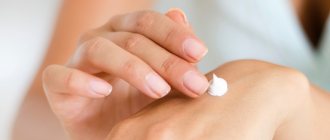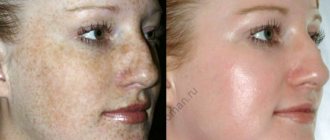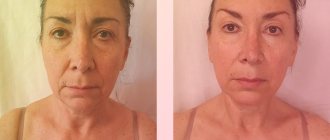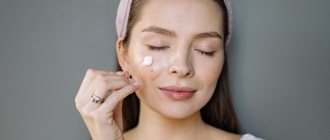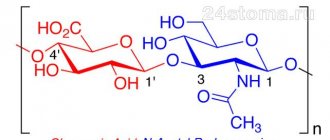Hyaluronic acid (HA), or hyaluronate, is one of the most important components of the intercellular fluid. It is “responsible” for retaining moisture in tissues, participates in the process of cell division, and ensures the circulation of lymphocytes, blood cells and oxygen in the body.
With age, the synthesis of hyaluronate decreases, which leads to tissue aging, including the skin. Injections of hyaluronic acid into problem areas help compensate for its deficiency and restore the skin to its former youth and elasticity. This method not only provides a significant anti-aging effect, but also allows you to correct facial features, which in general makes contouring a good alternative to plastic surgery.
Thanks to hyaluronic acid injections you can:
- eliminate wrinkles, including vertical folds between the eyebrows, wrinkles on the forehead, lips, eyes, neck and décolleté;
- smooth out nasolabial folds, nasolacrimal and lacrimal grooves;
- carry out lip contouring, that is, correct their shape;
- carry out correction of the earlobe and nose.
History of the study and use of hyaluronic acid
Hyaluronic acid was first isolated from the vitreous humor of the eye by Professor Meyer and J. Palmer in 1934. But it was only in 1947, under the leadership of Professor Bandi Balazs, that the basic properties of hyaluronic acid were determined.
In 1970, hyaluronate was recognized as an effective treatment for arthritis and one of the most promising components in surgical ophthalmology.
In 1980, the Q-Medlnc company first proposed the use of hyaluronate in aesthetic medicine, releasing a special preparation for the correction of defects in hyaluronic acid tissues. At the same time, hyaluronic acid was obtained not from animal components, but by the NASHA (bacterial fermentation) method, which ensured the drug maximum hypoallergenicity.
At the end of the last century, the Fidia Farmaceutici company opened a new era in contour plastic surgery by developing the drug IAL-Sistem, which is a chemically unmodified sodium hyaluronate. It interacts with cell receptors and stimulates their regeneration, that is, it starts the process of natural tissue renewal (biorevitalization).
The Danish company Novozymes has patented an innovative technology for synthesizing sodium hyaluronate from non-pathogenic Bacillus subtilis. The synthesis process eliminates the use of chemical solvents, which ensures the production of the purest hyaluronic acid to date, which has received GRAS status in the USA, that is, absolutely harmless.
What is biorevitalization?
biorevitalization - treatment of circles under the eyes
Biorevitalization is a method of intradermal injection of chemically unchanged (unstabilized) biointeractive hyaluronic acid to replenish the body's supply of lost hyaluronic acid, stimulate the production of its own hyaluronic acid and normalize metabolic processes in the skin, actually slowing down aging. There is a prolonged aesthetic effect on the face: the firmness, elasticity and color of the skin are improved due to the restoration and stimulation of the skin’s own reserve properties, the network of superficial wrinkles is smoothed out, and the skin looks several years younger.
Types of hyaluronic acid
There are many products containing hyaluronate, produced by different manufacturers and intended for different purposes. Only a specialist can determine which drug to use in a given situation, taking into account his own clinical experience, the properties of the drug and the individual characteristics of the patient.
In general, all drugs can be divided into several groups.
According to the molecular chains of hyaluronic acid:
- Low molecular weight hyaluronate - has anti-inflammatory properties, penetrates the cell barrier well, penetrates into the deep layers of the skin, stimulates tissue metabolism, and quickly disintegrates. Low molecular weight hyaluronic acid does not have a moisturizing effect because its molecules are too small to retain water, but they are excellent at transporting the necessary elements very deep into the tissue.
- Medium molecular hyaluronate - improves the regeneration process, usually used in the treatment of arthritis or in ophthalmic surgery.
- High molecular weight hyaluronic acid - disintegrates very slowly, stimulates all cellular processes and promotes fluid retention in tissues, which provides a pronounced moisturizing and rejuvenating effect. This is what is used in contour plastic surgery.
Stabilizers or crosslinkers
Crosslinkers, a term used by manufacturers, refer to substances that have been used to stabilize hyaluronate molecules by forming cross-links between them. Stabilization of hyaluronic acid molecules ensures a slower degradation of hyaluronate.
Hyaluronic acid used in cosmetology can be:
- stabilized (modified) - used in contour plastic surgery;
- unstabilized (native) - intended for mesotherapy or biorevitalization.
Different manufacturers use a variety of substances as stabilizers. Thus, in the production of Restylane, Juvederm and Belotero, the stabilizer 1,4-butanediol diglyceride ether (BDDE) is used; Prevelle Silk, Captique and Hylaform contain divinyl sulfone (DVS), while Prevelle Dura uses 1,2,7,8-diepoxyoctane ( diepoxyoctane - DEO), known as a "double binder" substance.
However, the above stabilizing agents may cause an allergic reaction and may also be toxic to the body. BDDE has the least toxicity. NEAUVIA ORGANIC has created a new generation of hyaluronic acid preparations using polyethylene glycol (PEG) as a cross-linker, which is 30 times safer than BDDE, reduces the risk of developing an immune response to the drug and suppresses the action of hyaluronidase (a group of enzymes in the human body that breaks down hyaluronate).
Preparations based on hyaluronic acid
Depending on the type of hyaluronic acid, there are several types of preparations made on its basis and used in cosmetology:
- Bioremedies - contain hyaluron, vitamins, micro- and macroelements, as well as bioactive substances, stimulate the process of synthesis of its own hyaluronic acid.
- Biorevitalizants - contain high molecular weight hyaluronic acid, stimulate the synthesis of elastin and collagen fibers.
- Mesotherapy cocktails are products that, in addition to hyaluron, also contain vitamins, peptides, lipolytics, coenzymes and various extracts.
- Fillers are preparations for correcting facial contours, cheekbone lines, lip contouring, and smoothing wrinkles. Fillers can be made based on hyaluron (Restylane, Juvederm, Stylege, Teosyal, Surgiderm) and other substances (Ellan based on polycaprolactone, Sculptra based on polylactic acid, Radiesse based on calcium hydroxyapatite). All fillers differ in concentration, cohesiveness (the ability of the drug to maintain its shape, not spread or dissolve) and elasticity, which is indicated by the G' value. Drugs with high G' are used to correct local defects, for example, eliminating the nasolabial fold, raising the tip of the nose or the lateral part of the eyebrows. Preparations with lower G' are used to correct large areas (cheekbones, lips, cheeks, etc.).
In medicine, two types of hyaluronic acid are used: animal origin and synthetic, which is fermented from specially grown microorganisms. The latter is considered the standard of modern cosmetology; it cannot become a source of infection or lead to the development of allergies.
Duration of the biorevitalization effect
It is possible to evaluate the result after the first biorevitalization procedure within 2 weeks. The skin on your face literally blossoms right before your eyes! After a course of procedures, noticeable results last from six months to a year. Moreover, the skin does not return to its original state; in any case, it will look better than before the biorevitalization course, even if several years have passed. The prolonged rejuvenation effect is ensured by stimulating the formation of new collagen and elastin fibers, improving microcirculation and restoring skin density. This is why biorevitalization with hyaluronic acid removes dark circles under the eyes!
Beware: fake!
Low-quality and counterfeit preparations with hyaluronic acid are extremely dangerous to use. They often contain bacterial material, which subsequently causes the development of inflammation, including purulent inflammation. Intradermal purulent infections are very dangerous, since purulent exudate can destroy adjacent healthy tissue. The infectious agent can spread throughout the body through the blood and/or lymph, which leads to the formation of secondary foci of infection. Such inflammations are extremely difficult to treat, require long-term therapy, leave deep scars, and sometimes tissue deformation develops, for example, deformation of the cheekbones, lips, and nose.
Almost all counterfeit drugs contain dangerous non-absorbable ingredients. Popular TV presenter Oksana Pushkina, instead of the original Restylane, had Artikol gel containing silicone and arteplast injected into her nasolabial fold. This was not a fake, however, due to the fact that the drug is not intended for correction of nasolabial folds, but is used for breast enlargement, as a result of its use, the injection area became swollen and literally blackened, and severe pain appeared. For this reason, Pushkina underwent quite complex treatment. In the case of a counterfeit drug, the reaction could be many times more severe.
Counterfeit hyaluronic acid preparations often lead to the formation of local necrosis. There is both a local and general increase in temperature. The tissues not only become inflamed, blacken and die, but ultimately form a large area of deformation of the soft tissues, and sometimes bones. Necrosis can occur with the formation of weeping, ulcers, the addition of a secondary infection and its spread throughout the body through the bloodstream. In some cases, sepsis may develop, which is often fatal.
It would seem that the simplest solution is to remove the fake from the body, but in reality this is a difficult task. Often, in order to completely remove foreign compounds, you have to go through the entire rejection process, which includes severe pain, inflammation, discoloration, sometimes suppuration, and ultimately the formation of deep scars. Specialists can only try to reduce the consequences of this process.
Most often, fake hyaluronic acid is used by self-taught craftsmen, “specialists” working at home, cosmetologists who have not undergone proper certification and work in offices not intended for such manipulations.
Any reputable medical center is responsible for the safety of all procedures performed by its specialists and purchases the necessary drugs from reliable suppliers. No responsible specialist will ever use untested products, including those brought by the patient. A qualified cosmetologist is always ready to show a certificate for the drug indicating the batch number and expiration date.
Avoid dubious savings. Health is something that cannot be neglected under any circumstances.
The result after the course of biorevitalization will be obvious:
- You will finally know first-hand what “inner skin glow” is.
- Be prepared that others will ask if you have returned from vacation, because your face will look rested and refreshed.
- Be prepared that others will think that you are in love.
- Be prepared to receive compliments on how good you look: “Fresh as a rose!”
- And no one will even guess that you slept little, worked a lot, or celebrated holidays vigorously. Dark circles under your eyes won’t give you away, because they simply won’t be there!
- In addition, one fine day you will catch yourself thinking that you need much less moisturizer than before, because your skin will become as hydrated as possible and will no longer need additional abundant hydration!
- And, the best part is that even in a few years your skin will look better than it does today! Over the years, like a good wine, you will look better and better!
You can read about the results and impressions after biorevitalization procedures in our clinic in the section REVIEWS ON BIOREVITALIZATION .
Methods of using hyaluronic acid
The cosmetologist’s task is not only to rejuvenate the patient’s skin and restore it to its former freshness, but also to preserve the unique beauty that nature has endowed man with.
Methods of introducing hyaluronic acid:
- Using needle injections: papular, tracer and canal techniques for administering drugs. Injections can be performed manually or using a special device with various attachments.
- The cannula contouring technique is a new method of introducing hyaluronate into problem areas, in which a longer and thinner flexible blunt microcannula is used instead of a needle. It does not pierce, but spreads the tissues apart, which makes the procedure less painful and traumatic, and allows one puncture to treat several adjacent problem areas at once.
- Alternative methods of hyaluronate administration such as laser therapy, electroporation, electrophoresis and ultrasound therapy. A gel with hyaluronic acid is applied to the skin in the problem area, then its deep penetration into the tissue is ensured due to the effects of ultrasound, laser beam, microwaves, and so on.
It is important that all cosmetic procedures are carried out by qualified specialists with extensive experience. In each specific case, the cosmetologist individually selects the drug, its concentration, quantity and method of administration.
On what areas of the skin is biorevitalization performed?
In pursuit of the beauty and youth of their facial skin, very often women neglect to take care of the skin of their neck and décolleté, and even forget about the skin of their hands! Such carelessness turns into the fact that it is the neck and arms that give away the age of the owner in the first place! After 35 years, the skin of the neck, décolleté, dorsum of the hands and elbows is in great need of hyaluronic acid. Only biorevitalization can restore beauty and youth to the skin of these “strategically important places” and carefully hide age.
For the convenience of our patients, we keep the lowest prices for biorevitalization in Moscow!
Procedure | PRICES |
| Primary consultation with a cosmetologist | 1 500 |
| Biorevitalization with SurgiliftPlus – 1 ml | 12 300 |
| Biorevitalization with IAL SYSTEM – 1.1 ml | 11 000 |
| Biorevitalization with IAL SYSTEM ACP – 1.0 ml | 12 400 |
| Biorevitalization with VISCODERM 0.8% | 10 100 |
| Biorevitalization with VISCODERM 1.6% | 10 700 |
| Biorevitalization with VISCODERM 2.0% | 13 300 |
| Biorevitalization with Hyaluform 1% 1 ml | 10 100 |
| Biorevitalization with Hyaluform 1.8% 1 ml | 10 700 |
| Biorevitalization with Hyaluform 2.5% 1 ml | 11 200 |
